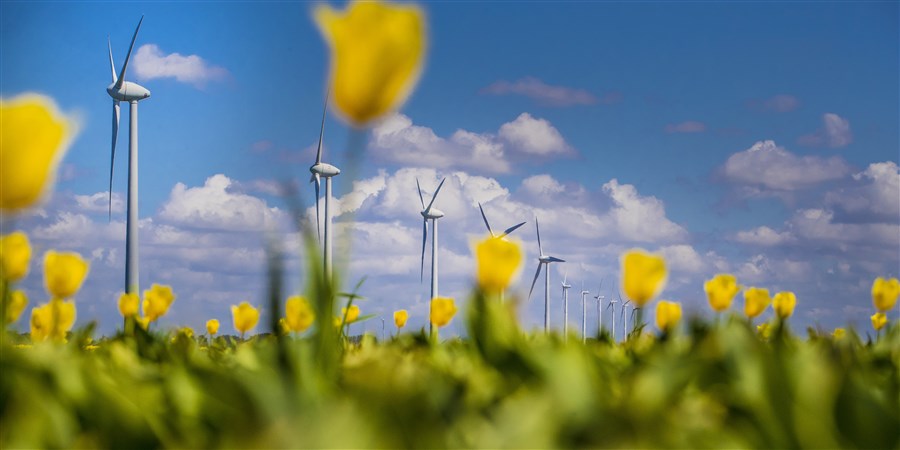CBS and DNB provide figures on sustainability and impact of climate change

Working in partnership
The Green Deal dashboard was launched by CBS in December 2023, and has been expanded significantly since then. It now contains a wealth of information, says Marleen Verbruggen, Director of Economic Statistics at CBS. 'The web page provides a good overview of the most relevant data that we have at CBS on these subjects and also includes data from other organisations. To achieve this, we collaborate with various partners, such as the Royal Netherlands Meteorological Institute (KNMI), DNB, Netherlands Environmental Assessment Agency (PBL), the National Institute for Public Health and the Environment (RIVM) and a number of ministries. They have agreed to share data with CBS so that we can present a broader, more coherent picture. CBS aims to include all relevant data in the dashboard.'Green growth
The European Green Deal is a set of policy initiatives developed by the European Commission with the goal of making Europe climate neutral by 2050. For example, CO2 emissions must be reduced by 55 percent by 2030, relative to 1990 levels. 'Those were the main goals of the previous European Commission. Climate change remains high on the agenda of the new EU Commission, but the emphasis has changed. For example, there is now a greater focus on Europe's market competitiveness, which is to be achieved through green growth. Economic growth and development are key, but the pressure on the environment and the use of natural resources must also be minimised,’ Verbruggen explains.CSRD Guidelines
Despite the shift in emphasis, the objectives set by the previous Commission remain in place. This also applies to the regulations on the statistics that CBS is obliged to produce regarding climate, nature, the energy transition, circularity, and so on. According to Verbruggen, this information is much needed. 'In January of this year, I attended a symposium in Brussels organised by the European Commission, the European Central Bank and the European statistics office Eurostat. One of the subjects we discussed was the need for information on corporate financing for the energy transition and the role that the CSRD (Corporate Sustainability Reporting Directive) guidelines can play in this. The guidelines require the largest businesses to report on a wide range of indicators in the areas of sustainability and environmental impact. This could also be an interesting source for statistics.’

Statistics on sustainability in the financial sector
Patty Duijm is Head of Department Securities, Sustainability and Payment Statistics at De Nederlandsche Bank. DNB also produces statistics on sustainability. ‘These are the sustainability statistics, which show the impact of climate change on the financial sector and the financing of the transition to a more sustainable economy. For example, our sustainability dashboards provide insight into the extent to which the financial sector is financing greenhouse gas (CO2) emissions as a result of their investment in businesses. This also allows us to determine the extent to which a financial institution is exposed to transition risk. This is the risk that carbon-intensive businesses will lose their value faster than expected as we transition to a more sustainable economy.’ Duijm illustrates this point with an example: ‘Suppose a bank lends money to a large number of garage owners who focus solely on cars that run on fossil fuels. Policies or changes in the market that lead to increased consumer demand for electric cars could pose a risk to that company's business model, and therefore a financial risk to the bank.’Changing climate
DNB also uses the dashboard to assess the physical risks of climate change. Duijm returns to the example of the bank and the garage owner. 'Suppose the garage is located next to a river. Climate change means that the river is more likely to burst its banks and cause flooding. If that happens and the garage and its inventory are severely damaged, the garage could default on its bank loan.’ This example illustrates why it is important for financial institutions to know how vulnerable businesses are to a changing climate when they provide credit.Quality improvement
The sustainability indicators were developed by DNB together with the European Central Bank and other national central banks in the euro area. DNB plays an active role in this within Europe. ‘The sustainability statistics were first published in 2023. The quality of the CO2 and physical risk indicators is not yet at the same level of our regular statistics. However, we will be working hard to improve this in the years to come. That is quite a complex job, though, because we depend on a wide range of data sources to produce this statistic, some of them external, and it is difficult to obtain accurate, timely and complete data. Data on CO2 emissions from businesses takes longer to produce, for example. Then the different data sets have to be linked together, and that involves some quite complicated methodology. Duijm points out that both CBS and DNB figures on sustainability are important. ‘This is also clear from CBS’s Green Deal dashboard. CBS and DNB take different perspectives when they produce their figures, but they complement each other well.’Related items
- Dashboard (Dutch only) - Dashboard green deal indicatoren
- Website - DNB - Dashboard - Sustainability in the Dutch financial sector